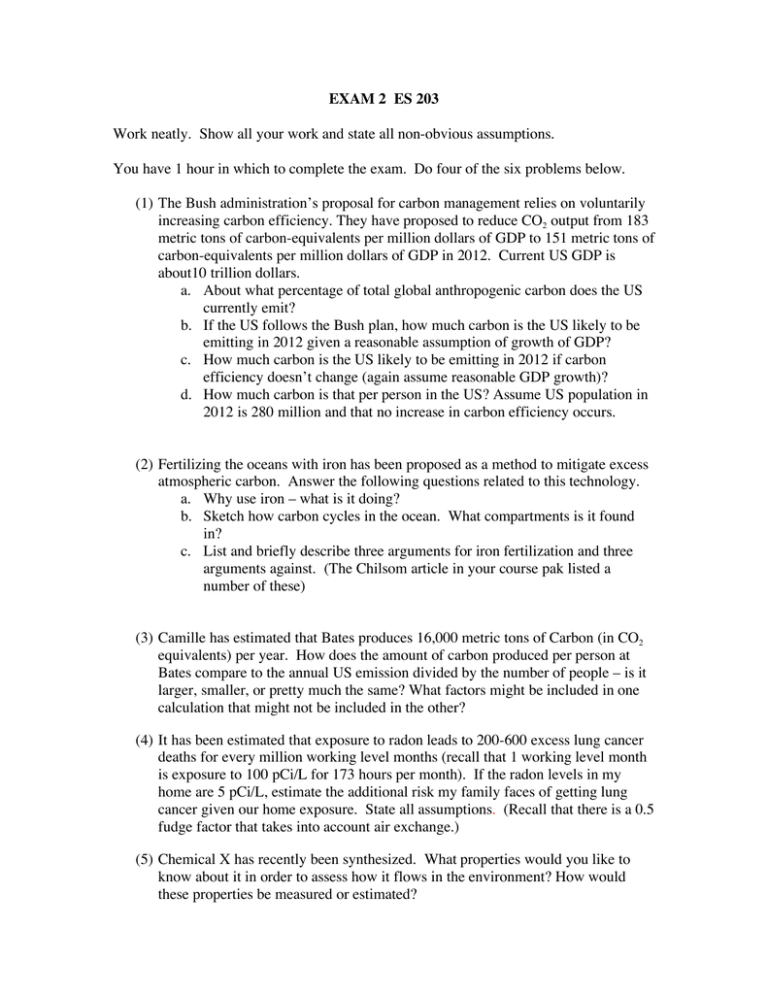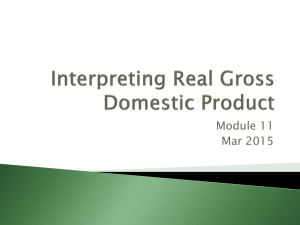EXAM 2 ES 203 Work neatly. Show all your work and state all non
advertisement

EXAM 2 ES 203 Work neatly. Show all your work and state all non-obvious assumptions. You have 1 hour in which to complete the exam. Do four of the six problems below. (1) The Bush administration’s proposal for carbon management relies on voluntarily increasing carbon efficiency. They have proposed to reduce CO2 output from 183 metric tons of carbon-equivalents per million dollars of GDP to 151 metric tons of carbon-equivalents per million dollars of GDP in 2012. Current US GDP is about10 trillion dollars. a. About what percentage of total global anthropogenic carbon does the US currently emit? b. If the US follows the Bush plan, how much carbon is the US likely to be emitting in 2012 given a reasonable assumption of growth of GDP? c. How much carbon is the US likely to be emitting in 2012 if carbon efficiency doesn’t change (again assume reasonable GDP growth)? d. How much carbon is that per person in the US? Assume US population in 2012 is 280 million and that no increase in carbon efficiency occurs. (2) Fertilizing the oceans with iron has been proposed as a method to mitigate excess atmospheric carbon. Answer the following questions related to this technology. a. Why use iron – what is it doing? b. Sketch how carbon cycles in the ocean. What compartments is it found in? c. List and briefly describe three arguments for iron fertilization and three arguments against. (The Chilsom article in your course pak listed a number of these) (3) Camille has estimated that Bates produces 16,000 metric tons of Carbon (in CO2 equivalents) per year. How does the amount of carbon produced per person at Bates compare to the annual US emission divided by the number of people – is it larger, smaller, or pretty much the same? What factors might be included in one calculation that might not be included in the other? (4) It has been estimated that exposure to radon leads to 200-600 excess lung cancer deaths for every million working level months (recall that 1 working level month is exposure to 100 pCi/L for 173 hours per month). If the radon levels in my home are 5 pCi/L, estimate the additional risk my family faces of getting lung cancer given our home exposure. State all assumptions. (Recall that there is a 0.5 fudge factor that takes into account air exchange.) (5) Chemical X has recently been synthesized. What properties would you like to know about it in order to assess how it flows in the environment? How would these properties be measured or estimated? (6) Explain how one would assess the risk to a population from exposure to lead if following the standard (EPA) approach to risk assessment. Go through each step of a typical risk assessment and explain what sort of information is required at each step and how the information obtained at each step connects to the next step. Provide as much detail as possible, including material from readings and hand outs to buttress your argument where appropriate.



